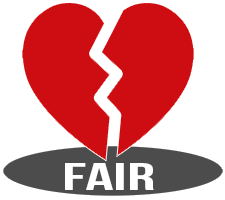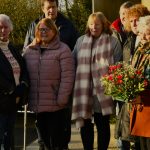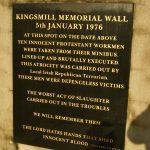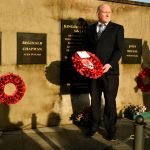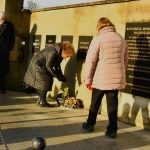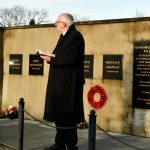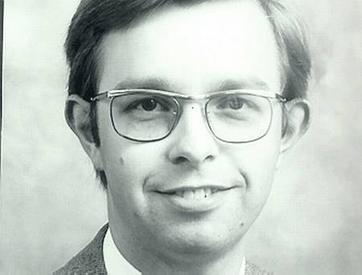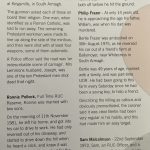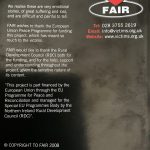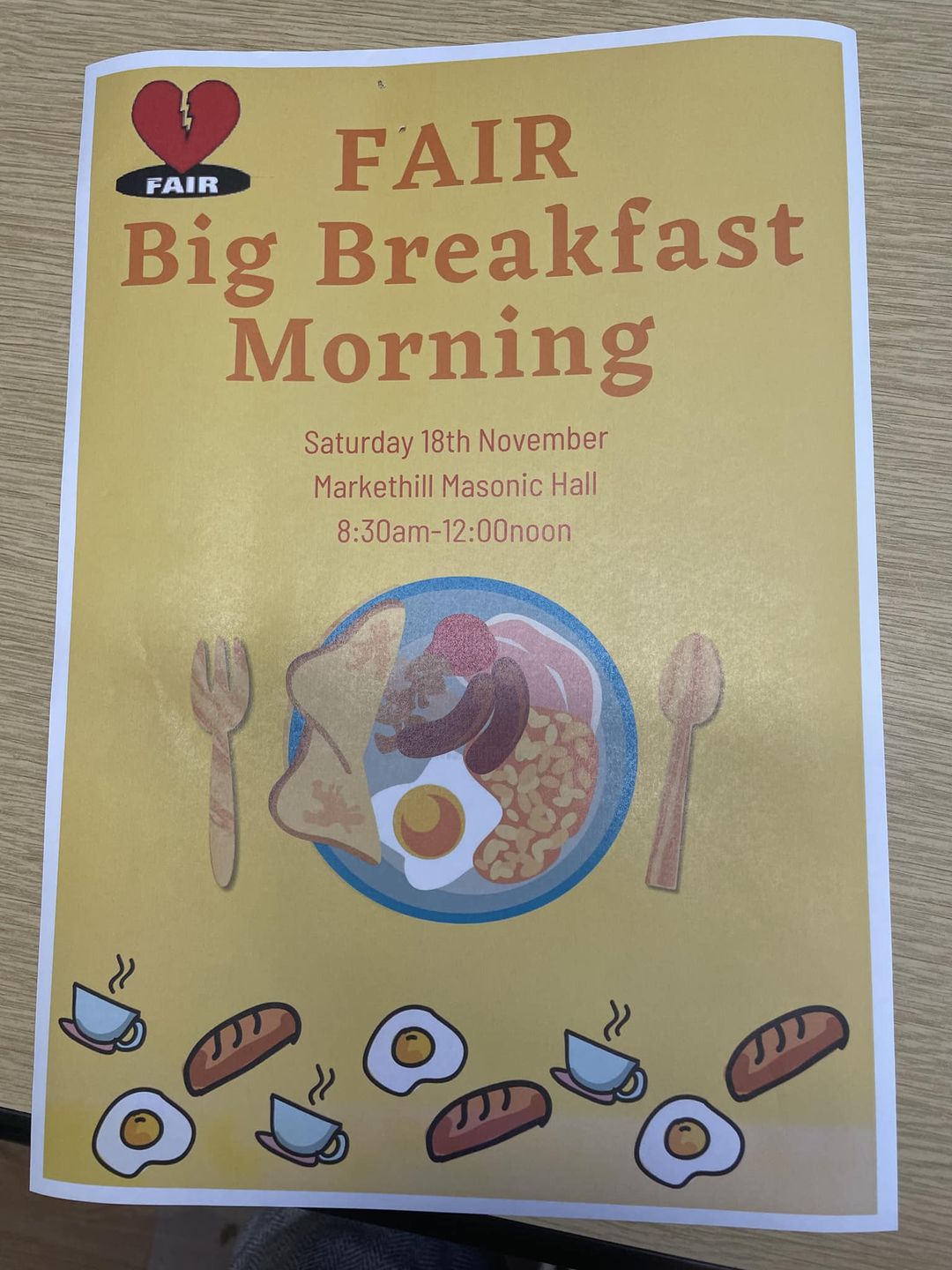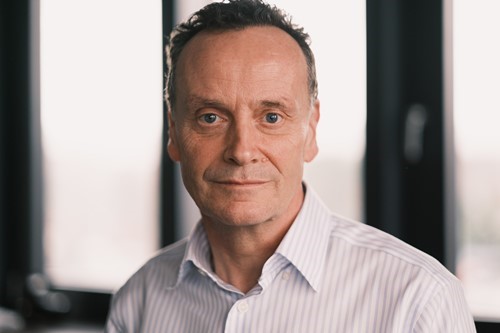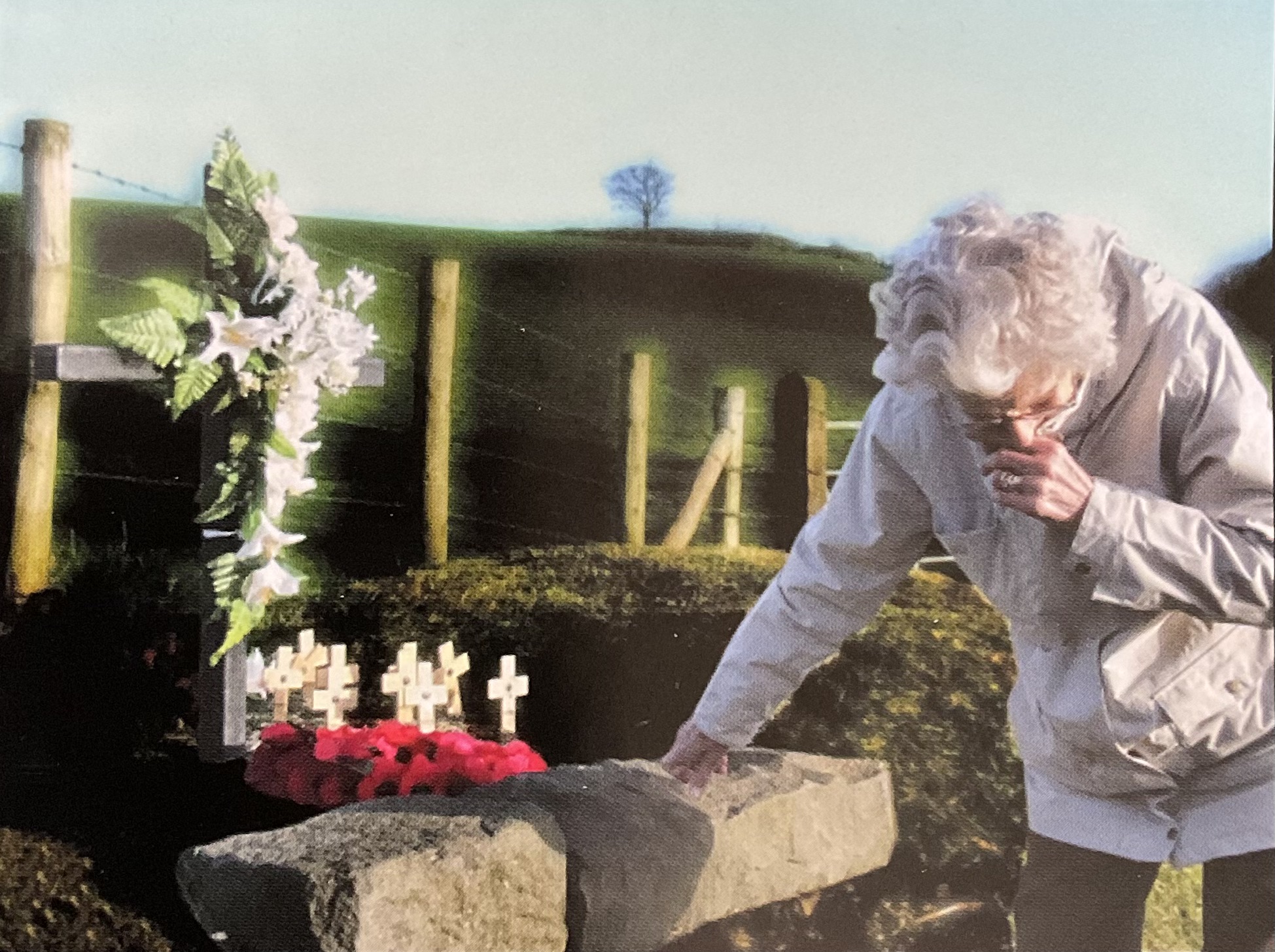FAIR Memorial Service Kingsmills
08/01/2024News,STORIES,Civilians,SUPPORT,Commemoration
Families Acting for Innocent Relatives (FAIR) paid tribute to the victims of the Kingsmills Massacre with a solemn memorial service in South Armagh. The event aimed to remember and honor the innocent lives lost during this atrocity, as well as to raise awareness about the ongoing pursuit of justice for the affected families.
The Kingsmills Massacre, which occurred in 1976, left a lasting impact on the community, as 10 innocent Protestant workers were brutally murdered by the PIRA while traveling home from work. To this day, justice has not been realised for the families affected by this senseless act of violence.
FAIR, a dedicated victims group committed to supporting those who have suffered from terrorism-related incidents, organised this memorial service to bring together the affected families, friends, and community members. The event provided an opportunity for collective reflection, healing, and solidarity.
The memorial service included representatives of FAIR, local community leaders, and family members directly affected by the Kingsmills Massacre. A moment of silence was observed to honour the memory of the victims, and attendees had the opportunity to lay flowers and wreaths in remembrance. A wreath was laid by FAIR Chairman and members of the group.

FAIR spokesperson stated, "The Kingsmills Massacre is a painful chapter in our history that continues to resonate with the affected families and the wider community. This memorial service was not only a tribute to the lives lost but also a call for justice and accountability. FAIR remains committed to supporting the affected families in their pursuit of truth and closure."
Members of the media were invited to attend the memorial service, which took place at Whitecross in South Armagh.
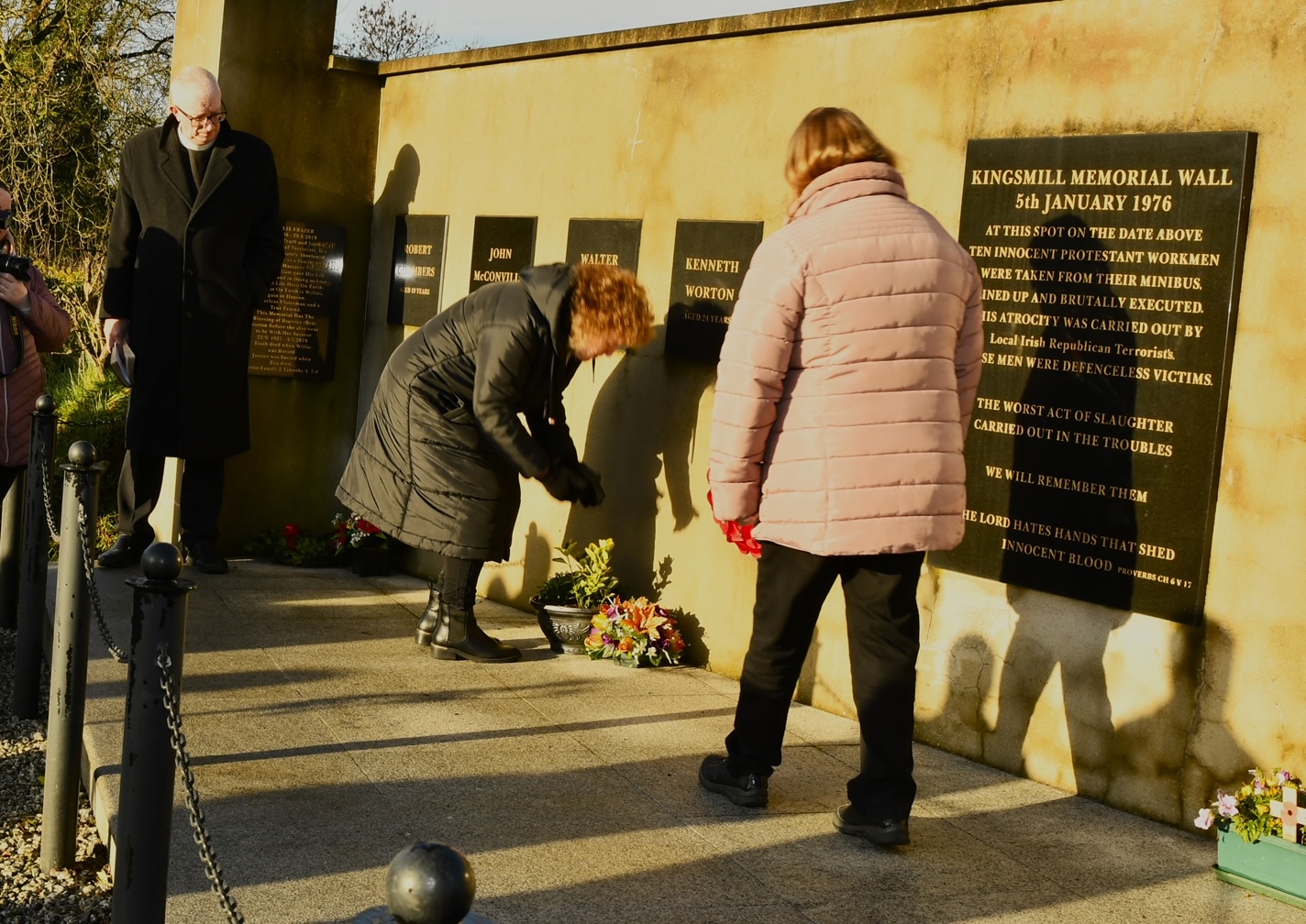
Kingsmills Massacre Memorial 2024
A memorial service for the 48th anniversary of the Kingsmill massacre was organised this morning by FAIR at the memorial erected to mark the victims of one of Northern Ireland's worst atrocities.
The lonely roadside in south Armagh was where 10 innocent Protestant workers were shot dead on a dark January evening as they returned home from work in 1976.
The memorial service was conducted by Rev Graham Middleton who expressed his “privilege and an honour” to take the service, and expressed his solidarity and support for the families.
The 48th Kingsmill Anniversary Remembrance service for the Kingsmill shootings at the memorial wall outside Whitecross in Co. Armagh. 10 Protestant men were shot dead by republicans after their work van was pulled in January 1976. Picture by Jonathan Porter/PressEye
Speaking at the memorial he said
“I guarantee you each one of those families, to each one of them, it’s just like yesterday because it’s still raw," he went on to speak of the comfort of God for those families many of whom were present.
The terrorist ambush had been carefully prepared with multiple killers taking part alongside support teams and scouts. It was not as some alleged a knee-jerk reaction to recent events, nor was it as the PIRA tried to claim an operation carried out by another group. It was a cold calculated act of sectarian barbarity against the minority Protestant population of South Armagh, part of a wider campaign to ethnically cleanse the entire border area of Protestants. That night the men were asked their religion, fearing it was the sole Roman Catholic who was the target they tried to protect him but the terrorists ordered him to flee the scene before murdering the remaining Protestants.
The 11 remaining men to line up outside the van before opening fire, those not killed in the initial hail of gunfire were systematically executed as they lay injured on the ground. Alan Black was the sole survivor, who despite being riddled with bullets lived as the bodies of his workmates covered him.
Family members of those killed during the Kingsmill Massacre laid flowers below plaques bearing the names and ages of the victims.
Jacqueline Semple’s brother Kenneth Worton one of the 10 men killed in the attack.
He was 24 at the time and Ms Semple was 22. She said losing her brother was “terrible”.
“There was five of us in the family and we just played normally and had a normal good upbringing and this was just devastation. Never in your wildest dreams – such a tragedy,”
“It was just hard. I was a bridesmaid at his wedding and then he was my best man and, like, there’s only really a year and a half between the two of us and we were so close.”
Ms Semple said it was “raw” to return to the site of the ambush.
“You have to be here. You know, it’s 48 years now and we’re coming here 48 years,... I’m not one for graveyards. I mean, they’re up there, they’re in your heart. But this is nice to have somewhere to go.”
Mourners sang a hymn and a two-minute silence was observed
As the 50th anniversary of the attack approaches, Ms Semple said her family will always remember Mr Worton.
“We speak about him all the day, his photograph’s up, we’re always talking about him.
“And then his two daughters, they were only six and three, and it’s just, it’s a brother, you’ve lost as a whole.
“This was a big thing, like, in 76. I mean, it felt like something out of a different country.
“It brings it all up. It’s hard. It’s hard. He’s always there. He’s always mentioned. Never forget, until the day we die.”
Edgar Graham Anniversary
06/12/2023News,Civilians,Campaigns
As we reflect this week on the murder of Human Rights Lawyer Edgar Graham 40 years ago we wonder what his thoughts would have been on the recent Legacy Legislation. We hear much about the killing of so-called human rights lawyers by loyalist paramilitaries, however little has been said and few inquiries have been launched into the serial murder of legal and judicial figures by the PIRA. Edgar Graham was first and foremost a lawyer, an academic and expert who pioneered human rights law in Northern Ireland. In his human rights work Edgar dedicated many hours to working on advancing an application to the European Commission of Human Rights on behalf of 32 applicants, most of whom were widows from the border areas of Northern Ireland and victims of what amounted to an ethnic cleansing of Protestant residents.
A Rising Star
Educated at Ballymena Academy, he graduated with a law degree at Queen's University Belfast (QUB) in 1976, and pursued postgraduate study at Trinity College, Oxford, from 1976. In 1975 Graham was vice-chair of the Queen's University Conservative and Unionist Association; in 1978 during his studies at Cambridge he joined the centre-right Bow group within the Conservative party. In 1979 he became lecturer in constitutional and European Community law at QUB and at the time of his death he was completing a doctorate. Edgar was called to the Northern Ireland bar in 1980, and swiftly established an outstanding reputation. He was assistant editor of the Bulletin of Northern Ireland Law, and in 1982 a fellow in European law at the Salzburg seminar. He made legal submissions to the European Commission of Human Rights on behalf of the widows of victims of terrorism. He published a pamphlet denouncing the Republic of Ireland's unwillingness to extradite terrorist suspects; at the time of his death he was completing another on Sinn Féin's links to paramilitarism, calling for the party to be proscribed and its leaders prosecuted.

He pioneered the use of new and innovative legal avenues to tackle terrorism. As an outspoken defender of the supergrass system, provided the court knew the terms of the deal between state and witness, he pointed to its effective use against the Italian Mafia, and attacked the ‘sophisticated propaganda campaign’ against it.
However it is for his visionary use of Human Rights Law and the European Court of Human Rights to challenge terrorism for which we remember him. He was the first to define and condemn the actions of the PIRA as abuse of Human Rights forming the European Human Rights Unit which represented the case of victims of terrorism for the first time presenting cases to the European Human Rights Commission and United Nations Human Rights secretariat. Alongside local MP Harold McCusker he focused on South Armagh to build his case and exposed the sectarian nature of the PIRA's campaign as well as at the collusion and complicity of the Irish Government in terms of their failure to extradite terrorists.
Speaking in the Northern Ireland Assembly months before he was murdered he was one of the first to use the term 'genocide' for what was happening to border Protestants. In an article in the Belfast News letter in February 1983 we read:
"IRA in ‘campaign of genocide on border’ THE Provisional IRA has mounted a campaign of genocide against the Protestant population in Ulster’s border areas, ‘the Assembly heard yesterday. South Belfast Official Unionist member Edgar Graham said the republican terrorist group was bent on eradicating a particular group of people simply because of their religion. He said many of the group's victims in the border areas had simply been killed because they were Protestants, not because they were members of the security forces. Mr Graham was putting forward a motion condemning Eire's attitude to extradition. It also called on the Government to press the Eire Government to introduce extradition and not to accept any substitute. Mr Graham claimed that extradition was the one major obstacie to the defeat of terrorism in Ireland and it was about time the Eire Government woke up to its responsibilities."
He championed the case of Edith Elliott whose husband George Elliott and brother Jack Donnelly had both been murdered along with over 30 other cases as they exposed the human rights abuses suffered by victims. It was obvious that framing the Troubles in terms of Human Rights was the most potent weapon against terrorism.

The light of that truth and with the effective operation of justice there was real hope that in the early 1980s we could have seen an end to the violence. As a campaign was launched in Europe, the United States and internationally with lawyers taking the lead there was a real hope of truth and justice securing a real peace here. We believe that such was the threat to terrorist organisations of this victims centred lawyer led approach that they determined to kill it at birth. The murder of Edgar Graham who was the brains behind the new strategy and the acceptance by the British Government of the Anglo Irish Agreement effectively killed the initiative. Sadly the unionist community were distracted for almost 15 years and in that time it was the terrorists who took up the tools and terminology of human rights. They literally killed Northern Ireland's human rights lawyer and stole his ideas. We have seen the sickening irony since of generations of lawyers twisting Human Rights to suit the cause and support the actions of terrorism.

It was only in 1998 with the Long March and the foundation of victims groups led by FAIR that real victims rediscovered the value of Human Rights to frame their case. Many of the same victims supported by Edgar Graham joined FAIR and the research around Human Rights abuses and Extradition which was was secured by Edgar in the 1980s was handed over to FAIR's Research and Policy Unit forming the foundation of our work. It was taken forward and formed the basis of what we termed LAWFARE and once more helped victims secure truth and justice. We pay tribute to the life and work of Edgar Graham, the vision he had of supporting victims and securing justice. We continue that work today and are proud to carry on what he started over 40 years ago. As his headstone and memorial in Stormont says
Attack upon the Rule of Law
We must remember that central to the PIRA terrorist strategy was an assault upon not only the police but the judiciary and legal profession. Attack on court houses and their staff as well as widespread witness intimidation and wholesale efforts to subvert the criminal justice system was part and parcel of their strategy. Other senior legal figures murdered include:
- 11th of October 1972 - Resident Magistrate William Staunton, a Catholic, shot dead on the as he drove his daughter, Sally-Ann, to St. Dominic’s convent grammar school on the Falls Road.
- 16th of September 1974, Judge Rory Conaghan, a Catholic, murdered at his home in front of his 9 year old daughter, Deirdre.
- 16th of September 1974, Resident Magistrate Martin McBirney, a Protestant, at his home in front of his family.
- 16th of January, 1983, Judge William Doyle was murdered by the IRA as he came out of Mass in St. Brigid’s Catholic church on Derryvolgie Avenue in Belfast
- 28th of April, 1987, the IRA murdered 73-year-old Appeal Justice Maurice Gibson and his wife Cecily by bombing their car at the border, with collusion between the IRA and the Irish police, An Garda Siochana
- 23rd of July, 1988, in a repeat attack the PIRA tried to murder Catholic Justice Eoin Higgins and his wife but instead killed the entire innocent Hanna family.
The story of his Life and Death
An excellent article and series of podcasts by the Belfast Telegraph have highlighted the the PIRA murder of Edgar Graham a true human rights lawyer whose vision for Northern Ireland was cruelly cut short. In his own words we hear him highlighting the plight of border farmers who themselves lived under threat of assassination. In the chilling account of the murder of this bright young man.
Edgar Graham was just 29 years old when the IRA gunned him down on the street at Queen’s University in south Belfast.
The young law lecturer and unionist politician had a brilliant mind and was widely believed to be a future leader of the Ulster Unionist Party. David Trimble said he’d never have been Ulster Unionist leader if Edgar had lived.
Forty years after a crime which even by the standards of the Troubles shocked Northern Ireland, Sam McBride investigates why the IRA targeted him, whether he was set up by a colleague, and where this lost leader of unionism might have led Northern Ireland.
In this BelTel special documentary, Edgar’s friend Dermot Nesbitt, who was standing beside him when he was killed, revisits the scene for the first time in 20 years as he and others who knew Edgar well tell his story.
Killing Edgar: The IRA murder of Edgar Graham (part one)
Edgar Graham didn’t stand a chance. A gunman approached him from behind, shooting him dead just yards from the law faculty at Queen’s University where he worked.
At just 29, he was one of the most outstanding politicians the Ulster Unionist Party had ever produced and overwhelmingly likely to be a future party leader.
How would he have changed Northern Ireland if he had gone on to lead unionism?
The IRA immediately admitted responsibility for his murder, but why was he singled out?
And Sam McBride tracks down a fellow law lecturer accused of helping the IRA to target Edgar. He hears his first direct comments on the accusations in the 40 years since the killing.
Festival of Remembrance 2023
02/12/2023Events,News,Events-Activities,SUPPORT,Commemoration
FAIR had a party of 57 attend the Festival of Remembrance in Belfast last night. some members drove there due to restriction in coach 53 seater. They all enjoyed a meal in a Local hotel making this a special evening together. Chairman and wife along with befriending coordinator and Project Manager enjoyed a great view seated in the VIP seating. We were proud to see one of our victims Krystal taking part in the service with a presentation to Lady Brookborough. It was a tremendous evening with fully packed programme of music and dance followed by Service of Remembrance. Excellent and much appreciated event enjoyed by everyone. Thanks and appreciation to the RBL for all their hard work in getting such a great programme together.

Sammy Hamilton's Story
01/12/2023STORIES,Constabulary
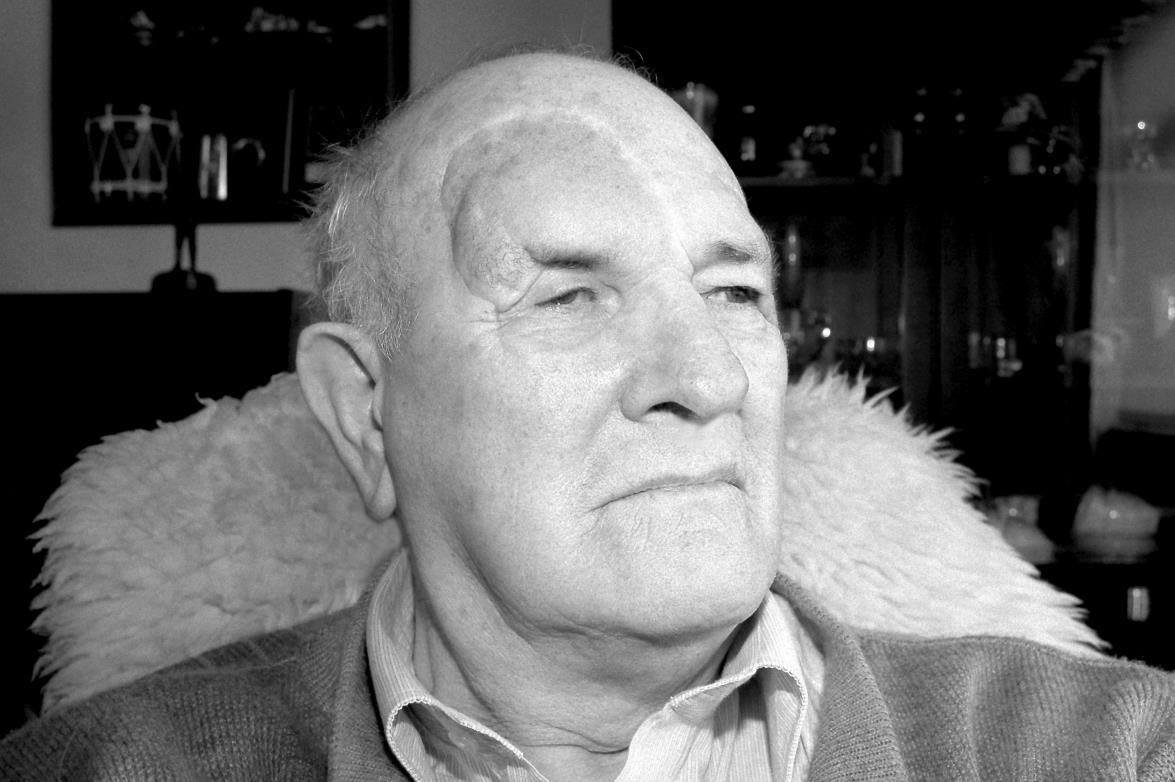
Sam Malcolmson
01/12/2023STORIES,Constabulary
Sam had joined the police force in 1969 as a young man and because he had served only three years when he was shot, he has suffered with life changing injuries for five decades surviving on the lowest pension. He has been involved with FAIR since 1998 often at the forefront of campaigns to expose the injustice and inequality faced by many former police officers. His advocacy work for victims has spanned the decades when he founded the Disabled Police Officers' Association (DPOA).

“Pain can leave you sometimes very depressed and in a bad mood” His family have had to live with this, but he is very grateful of their support over the years. “To date we’ve survived, a lot of that is down to the guidance of my wife” Saml Malcolmson
He has been a consistent voice for victims often telling his own painful story to highlight the wider suffering of victims and the absence of justice or truth from the PIRA who were behind the attempt to murder him and his colleague in 1972. FAIR featured Sam's story in their powerful video presentation of victims stories.
Injured In The Troubles - Sam Malcolmson from Northern Visions NvTv on Vimeo.
A powerful video interview with Sam recorded for Our Generation Injured In The Troubles Samuel Malcolmson
Marie Breen-Smyth, Associate Dean International, University of Surrey, talks to Samuel Malcolmson about the injuries he received in a terrorist attack and how it’s effected his life.
In 1972 Samuel Malcolmson was stationed in Crossmaglen in South Armagh when he and a colleague drove into an ambush, they were both shot in the back but they manged to make it back to their Police Station because of the driver, even though he too was shot “I do owe my life to him because he was able to control the car to the police station, I think he was just about to pass out, he actually crashed into the gates”
He remembers being injected with morphine by the local doctor. “I didn’t think you could suffer so much pain, and then I can remember on the way down to the hospital in the ambulance the attendant was trying to keep us on the plinths as they were going around the twisty roads and then after that I don’t remember anything”
Samuel was airlifted to the Royal Hospital in Belfast were he spent nine months. “My two legs were out of action for quite a while, but then lucky enough one of my legs came back to full use but the left leg is now left with paralysis, I excepted the fact that somebody shot me, I was a legitimate target in his eyes but the one thing I could never except was weeks later when my father had to come up to the hospital and tell me that my mum had dropped dead at my bedside, that was the hardest thing to take and to this day him and I can not talk about this incident”
Samuel now suffers from severe back pains and shooting pains up and down his leg, he has to use elbow crutches to walk long distances. “The home and the car are my life, as far as walking is concerned I would do as little as possible because it triggers the pain”
Samuel still thinks about the man who did this to him. “I still want to meet the person who pulled the trigger and I’m convinced I know him, circumstances would narrow it down to a couple of people, there’s not a day in life that goes by were I don’t think of that person, when he and the person with him shot me. The following day when my mum dropped dead beside my bed, did he think ‘I’ve gone to far here I didn’t mean for an innocent person to suffer’ I was a legitimate target in his eyes but did his conscience have a twinge and did he think, ‘There’s a family left now without a mum’ or did he think ‘No that’s even better than I thought, I went out to get two cops and I’ve got three people, I’ve ruined their lives in different ways’ so I still want to meet that person, I want to sit eye to eye and talk to them”
Although it has effected his everyday life, Samuel is still determined to keep a level of independence.
Big Breakfast Fundraiser
19/11/2023Events,News,Events-Activities
Big Breakfast Fundraiser
FAIR wish to thank everyone for their support today with their BIG BREAKFAST, for those who attended and all our volunteers for their hard work. A very successful event. All donations go to FAIR Fundraising account.
Thank you to everyone .
Victims Commissioner Resigns
Ian Jeffers, Commissioner for Victims and Survivors has resigned from the post adding further uncertainty at this crucial time. While we wish him well in his new post we must note that there are many things which have been left undone and many issues which victims require leadership and a voice to challenge. It is time to reconsider the role and relevancy of the Commissioner especially in light of the recent roll mover on the roll our of the Legacy legislation.
Mr Jeffers said in his resignation statement
“It is with mixed emotions that today I tendered my resignation as Commissioner for Victims and Survivors to accept the post of Chief Executive of Cooperation Ireland.
I took up the post of Commissioner with the sole aim of making a difference for victims, survivors and our society more broadly, and I can honestly say it has been an honour, a privilege and – at times – a huge frustration.
There is little in Northern Ireland society that cannot be linked in some way to the legacy of our past; our divisions, our government and the many transgenerational issues we continue to face.
It is unfortunate that my tenure was in the context of having no devolved administration in Northern Ireland but throughout this challenge, I always found great hope through the many people bringing positive drive to carve a better way forward; the strength and determination of the Victims and Survivors Forum who continually use their lived experiences for the greater good, the staff team at the Commission, and countless others I have engaged with over the past year 18 months.
In my new role with Cooperation Ireland, I look forward to continued collaboration with these individuals and building on this important work.”
International Congress of Victims of Terrorism
23/10/2023Cat 1,Advocacy,News,Campaigns,Counter-Terrorism
FAIR represented Northern Ireland's victims at a series of International Congresses where the voice of innocent victims were amplified and issues debated.
The International Centre for Victims of Terrorism of the San Pablo CEU University Foundation is the institution that established the International Congresses of Victims of Terrorism, which were born with a double objective: to be a forum where the voice of the victims could be heard and to help them to have the recognition they deserve, both by society and authorities.
These Conferences have already been held six times: Madrid (2004), Bogotá (2005), Valencia (2006), again in Madrid (2008), Medellín (2009) and Salamanca (2010). They have taken part in them more than 2.500 terror victims from different countries: Argelia, Argentina, Chile, Colombia, Congo, France, Indonesia, Ireland, Israel, Italy, Mexico, Netherlands, Peru, Russia, Rwanda, Spain, United Kigdom, United States and Uruguay.
Ist International Congress of Victims of Terrorism (Madrid)
 In 2004, the San Pablo CEU University Foundation and the Foundation for Victims of Terrorism (Spain) organized the first edition of the International Congress on Victims of Terrorism in Madrid. The main objective was to recognize the strength of victims of terrorism, who are often forgotten. This way, they could feel the warmth, respect and affection of the entire society. This first edition was opened by HRH Felipe de Borbón, Prince of Asturias. In this first Congress, victims of terrorism from United States, Israel, Ireland, Colombia, Argelia and Spain had the chance to speak and share their experiences. Politicians, judges and journalists spoke about how important was not to forget the victims of terrorism. The closing lecture was given by Mr. José María Aznar who, by that moment, was President of the Spanish Government.
In 2004, the San Pablo CEU University Foundation and the Foundation for Victims of Terrorism (Spain) organized the first edition of the International Congress on Victims of Terrorism in Madrid. The main objective was to recognize the strength of victims of terrorism, who are often forgotten. This way, they could feel the warmth, respect and affection of the entire society. This first edition was opened by HRH Felipe de Borbón, Prince of Asturias. In this first Congress, victims of terrorism from United States, Israel, Ireland, Colombia, Argelia and Spain had the chance to speak and share their experiences. Politicians, judges and journalists spoke about how important was not to forget the victims of terrorism. The closing lecture was given by Mr. José María Aznar who, by that moment, was President of the Spanish Government.
IInd International Congress of Victims of Terrorism (Bogota)
 The second edition was held in February 2005 in Bogotá (Colombia). On this occasion, Sergio Arboleda University in Bogotá organised the event. The opening lecture was given by Mr. José María Aznar, and Álvaro Uribe, President of the Republic of Colombia gave the closing lecture. Victims of terrorism from Colombia and other Latin American countries, Russia, Spain, Indonesia, Ireland, United States and Israel attended the conferences.
The second edition was held in February 2005 in Bogotá (Colombia). On this occasion, Sergio Arboleda University in Bogotá organised the event. The opening lecture was given by Mr. José María Aznar, and Álvaro Uribe, President of the Republic of Colombia gave the closing lecture. Victims of terrorism from Colombia and other Latin American countries, Russia, Spain, Indonesia, Ireland, United States and Israel attended the conferences.
IIIrd International Congress of Victims of Terrorism (Valencia)
 In February 2006, Cardenal Herrera CEU University in Valencia hosted the III International Congress of Victims of Terrorism. The venue was the Palace of Congresses of the Valencian capital, where more than 700 people registered, including victims of terrorism and attendees. Terror victims from Peru, Russia, United States, Ireland, United Kingdom, Colombia and Spain took part.
In February 2006, Cardenal Herrera CEU University in Valencia hosted the III International Congress of Victims of Terrorism. The venue was the Palace of Congresses of the Valencian capital, where more than 700 people registered, including victims of terrorism and attendees. Terror victims from Peru, Russia, United States, Ireland, United Kingdom, Colombia and Spain took part.
TRH Prince and Princess of Asturias opened the third edition of the International Congress on Victims of Terrorism. The closing lecture was given by Mr. José Antonio Alonso, Minister of Interior of Spain. Mr. Francisco Camps, President of the Autonomous Community of Valencia, and Mrs. Rita Barberá, Major of Valencia, also spoke at the closing lecture. During this edition, the attendees had the opportunity to see a photographic exhibition by Miguel Angel Blanco Foundation, which showed the cruelty and the tragic consequences of the terrorist scourge.
IVth International Congress of Victims of Terrorism (Madrid)
 The IVth International Congress of Victims of Terrorism was held at the San Pablo CEU University in Madrid in January 2008. More than 400 victims of terrorism from different countries which have suffered, and still suffer, terrorist attacks (United States, Ireland, Israel, Peru, Uruguay, France, Colombia, Argentina, Holland, Italy and, of course, Spain) attended the event.
The IVth International Congress of Victims of Terrorism was held at the San Pablo CEU University in Madrid in January 2008. More than 400 victims of terrorism from different countries which have suffered, and still suffer, terrorist attacks (United States, Ireland, Israel, Peru, Uruguay, France, Colombia, Argentina, Holland, Italy and, of course, Spain) attended the event.
Among the participants in the fourth edition were TRH Prince and Princess of Asturias, who opened the Congress; Mr. Alvaro Uribe, President of the Republic of Colombia; Mr. Fernando Araujo, Minister of Foreign Affairs of Colombia; Mrs. Esperanza Aguirre, President of the Community of Madrid; and Mr. Mariano Rajoy, leader of the main opposition party in Spain. During this Conference, the attendees could also see the photographic exhibition of the Miguel Ángel Blanco Foundation.
Vth International Congress of Victims of Terrorism (Medellin)
 With the background of the four editions, in May 2009 took place in Medellín (Colombia) the V International Congress of Victims of Terrorism. It was organised by the Colombian institutions Visible Victims Foundation and Sergio Arboleda University, in collaboration with the International Centre for Victims of Terrorism of the San Pablo CEU Foundation.
With the background of the four editions, in May 2009 took place in Medellín (Colombia) the V International Congress of Victims of Terrorism. It was organised by the Colombian institutions Visible Victims Foundation and Sergio Arboleda University, in collaboration with the International Centre for Victims of Terrorism of the San Pablo CEU Foundation.
TRH Prince and Princess of Asturias attended the Inaugural Ceremony and they were accompanied by Mr. Álvaro Uribe, President of the Republic of Colombia and other authorities. Nearly 1.000 victims of terrorism from different countries, including, Rwanda, the United States, Northern Ireland, Mexico, Argentina, Chile, France, Spain and, of course, Colombia, attended the Conference. The closing lecture was given by Mr. Felipe Calderón, President of México.
VIth International Congress of Victims of Terrorism (Salamanca)
 Finally, the Sixth International Congress of Victims of Terrorism was on February 11th – 13th 2010 in Salamanca. Over 400 victims of terrorism from different countries which have suffered or are suffering from this scourge, such as Argentina, Congo, Colombia, United States, France, Ireland, Israel, Italy, United Kigdom, Russia and Spain, took part. Once more, the opening ceremony was given by TRH Prince and Princess of Asturias, and Mrs. Arantza Quiroga, President of the Basque Country Parliament gave the closing lecture.
Finally, the Sixth International Congress of Victims of Terrorism was on February 11th – 13th 2010 in Salamanca. Over 400 victims of terrorism from different countries which have suffered or are suffering from this scourge, such as Argentina, Congo, Colombia, United States, France, Ireland, Israel, Italy, United Kigdom, Russia and Spain, took part. Once more, the opening ceremony was given by TRH Prince and Princess of Asturias, and Mrs. Arantza Quiroga, President of the Basque Country Parliament gave the closing lecture.
During the events planned for this sixth edition it took place a tribute act, called Salamanca with the victims of terrorism, where the inhabitants had the opportunity to participate directly in the Congress and express their affection and solidarity with victims of terrorism. Thousands of people gave their support to the victims in the Salamanca’s main square.
VIIth International Congress of Victims of Terrorism (Paris)
The French Association of Victims of Terrorism (AfVT.org), member of the European Network of Associations of Victims of Terrorism (NAVT), in partnership with the International Observatory for the Victims of Terrorism (CEU), organized the VIIth International Congress of Victims of Terrorism that recently took place September 15-17, 2011 at the amphitheatre Foch of the Military School of Paris.
This was the first time that the International Congress of Victims of Terrorism took place outside a Spanish speaking country. The VIIth International Congress of Victims of Terrorism in Paris included representation of victims of terrorism from 29 different countries around the world and included victims, civil society actors, political leaders, representatives of various institutions, international experts and journalists.
Comity of Honor
Finally, it is worth highlighting that the six editions of the International Congresses on Victims of Terrorism have had superb Honour Committees, including TRH Prince and Princess of Asturias, the President of the Spanish Government, the President of the Republic of Colombia, the President of the Congress Deputies and Senate of Spain, several Presidents of the Governments from Spain and Colombia, the Ombudsman and regional authorities, such as the Presidents of the Autonomous Communities of Madrid, Valencia, Castilla y León and the Mayors of Madrid, Valencia, Medellín and Salamanca.
Remembering Former Chairman
Remembrance - Harry Bell MBE. Who passed away a year ago. Harry was a dedicated President of FAIR, a victim who lost 5 other members of his family. He had worked tirelessly as Chairman for many years and his dedication to the group saw many results. As a building contractor his knowledge and experience was vital as we secured and renovated and developed our Living Memorial Centre. The building is in many ways a lasting legacy to his time as Chairman.

We are thinking about his family as we remember Harry.
